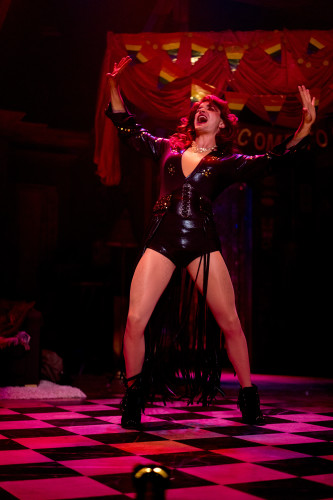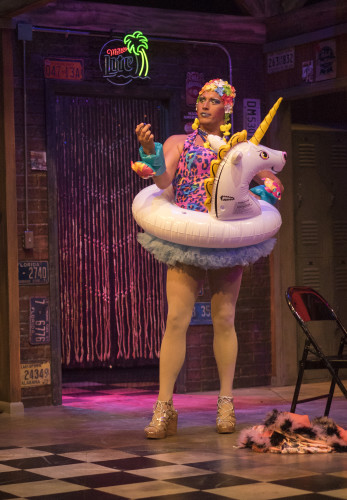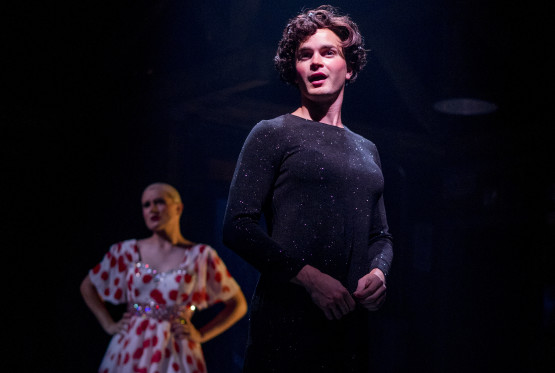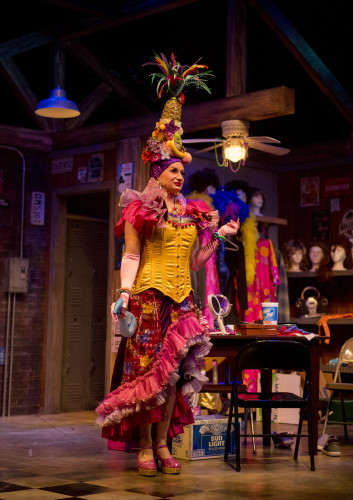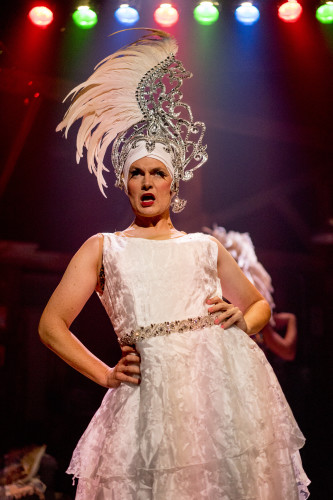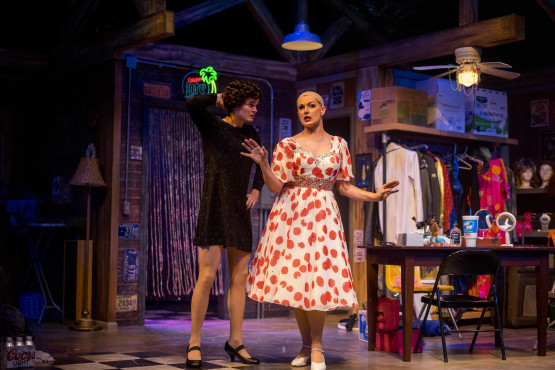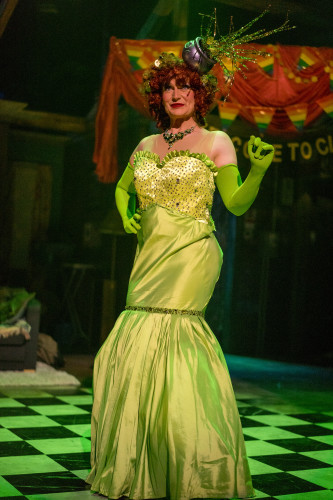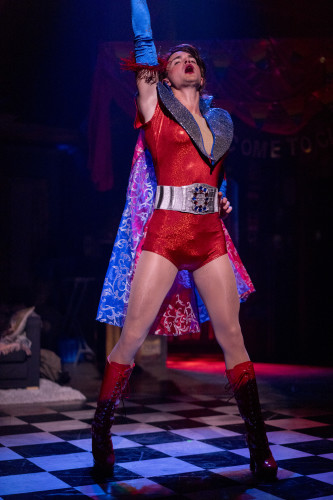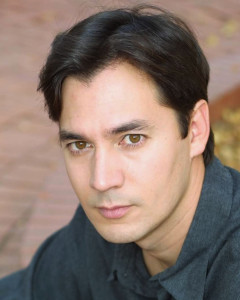The Last Wife: Designs and Inspirations
We are taking you behind the scenes of The Last Wife with the design team to get a glimpse into the process of creating this exciting production. Read on to find out, in their own words, where their inspirations and designs for this powerful play came about.
Veronica Murphy – Costume Designer
“This is a contemporary play about historical figures. The playwright calls for contemporary clothing so you might think that would make it easy. Not necessarily so. These are royals and we need to believe they are royals. The play spans four years with many changes in the characters’ positions – and in the case of Bess, she goes from a child of 11 to a young adult of 15. The scenes flow like Shakespeare, often seamlessly from bedroom to dining room to hallway, to conference room and so on.
A monochromatic set – we chose monochromatic costumes with touches of color, crimson for the Tudors (also the real Katherine Parr’s favorite color) and blue for the Seymour’s. Thom is, after all, a man of the sea. And the young prince follows in blue, as we are continually reminded that his mother was the beloved Jane Seymour. As Kate gains her place in the palace, her lines are less fluid and more structured and powerful, while maintaining femininity, so important in keeping Henry on her side. And once she marries Thomas Seymour, she is also in blue. Everyone is trying to please the King, save Mary, the Catholic rebellious daughter. Note the clerical lines that tie her to the church. Ironically, she is in black, like her father, but without any crimson, so as not to suggest her later nickname “Bloody Mary.” As Bess is mothered by Kate and grows into her womanhood, her dress is similar to Kate in line and color. There is also all that getting dressed and undressed, especially for Kate, making the underwear just as important as the outerwear.
A challenging project like this has to have some whimsy so – Henry has a lapel pin in the style of U.S. politicians but it is a Tudor Rose, Prince Eddie’s blue pajamas are covered in castles and dragons and the various ruffled necklines are a consistent nod to the true period.”
Sean Fanning – Set Designer
“The world is a contemporary re-imagining of Henry’s space. It is raw and modernist, and inherently masculine. At the same time, we are using simplicity and open space to make a world that is less about scenic detail and more about the emotional worlds and power play between the characters. The main inspiration for the setting is the Japanese architect Tadao Ando – who created spaces that lived between the world of a dwelling and a public arena. I was inspired by how he used containment and enclosure, and then created ways for light to stream into the container. In a theatrical context, this helps us to change the space in evocative ways. There is a trinity of antlers that always lives on the wall – these stag horns represent Henry’s savagery and love of hunting and are one of the few nods to the period. They cast foreboding shadows across the wall when lit from above.
The container acts a little as a puzzle box, and has several key compartments or openings that then support the action or change the context of the scenes. There is a center door that can be opened to reveal a glowing upstage hallway. This opening can also be raised to be a tall opening for Henry’s Commission. There’s an upstage left opening that can be slid open to reveal an oversized brutal fireplace – this is used for several locations with different furniture arrangements. Upstage right is a similar door that is slid open to reveal a concrete bed that pulls out from the wall, and a little compartment in the wall that holds the basin and pitcher with which Henry’s wound is washed. Stage right has a drop-down opening for liquor in the Act 1 courtship scene and elsewhere.
We are also using some grand gestures as a part of the storytelling as well as the tall velvet banners with the Tudor Rose motif for the commission scene. Two rolling tables that are used throughout the play become joined together to create a 12-foot long dining table with a chandelier that flies in for the family dinner scene. For the top of the second act, “Training Day”, a flurry of books will drop from the sky and tumble to the stage. At the end of the show, the space gets transformed to a more feminine soft environment when we bring on a set of sheer draperies that cover and obscure the container.
By envisioning this environment as a cold, masculine and harsh shell representing Henry’s space – with a sense of charged and compressed spatial volume – we have created an opportunity or invitation for Katherine to come forth into that space and rise above it, and claim power.”
Kevin Anthenill – Composer & Sound Designer
Kate Confronts Henry Scene 4
Wedding Scene 5
“When approaching the sound design and score for The Last Wife there are a few key elements which are important to director Rob Lutfy and myself. The play is a modern telling of historical figures, so I wanted to create a soundscape which had both modern, synthesized elements, as well as classical instruments such as brass and strings. The intention when the brass is playing is to give the score a noble feel – to create a regal sense – a royal sense.
The strings are intended to center around Kathrine’s delicate touch, while still maintaining an air of class. The synthesized elements are deployed to create pace and drive. In a fast moving play, Rob Lutfy and I wanted to ensure the music was equally as driving. I intend to use the Synth-Pulse as a driving undercurrent that gives the sense of the “psychological thriller” genre.”
Catch The Last Wife through February 11th!
The Drag Glossary
In case you didn’t know, Drag culture has it is own vocabulary. Here is the beginner’s guide to drag-speak. We’ve selected 20 words to get you started. What are you waiting for? Get to werk!
1. Bar Queen
n. a drag queen who only performs in small bars. Typically used as an insult.
2. Beating Face
v. to apply the perfect amount of makeup on the face, resulting in a flawless look. The term references the motion of constantly dabbing a makeup sponge or brush against one’s face.
n. a false breast piece worn by drag queens to give the impression of female breasts. They are often made of flesh-tone silicon of rubber.
4. Busted
adj. a dilapidated drag queen who can’t make up or style properly, looking unkempt, unrefined, unpolished, generally poor presentation.
n. a drag queen’s given name as opposed to her stage name.
6. Butch Queen
n. a masculine-looking drag queen.
n. a slang term used to describe butt cheeks.
8. Camp Queen
n. a type of traditional, over-the-top drag act, with little effort at female impersonation.
9. Chicken Cutlets
n. a slang term used to describe padding worn by drag queens to give the illusion of having female hips and thighs.
10. Corset
n. an undergarment worn, that tightly fits around the abdomen of the queens to help create a proportioned, hour-glass figure.
n. a slang term for any woman or drag queen who is self-important, demanding, temperamental, or hard to please.
12. Drag King
n. a woman who dresses as or impersonates a man for entertainment/show purposes.
n. an experienced drag queen who acts as a mentor and guide to a younger, up and coming, less experienced, or apprentice drag queen.
14. Fierce
adj. a term used by drag queens meaning to possess a good, intense, satisfying, powerful, or beautiful quality.
adj. a term used to refer to a drag queen whose look is considered to be flawless, well executed, seasoned, and perfected.
16. Sashay
v. to strut with an elaborate roll of the shoulders and hips, from the ballet term chassé.
n. the casting of aspersions, bluntly pointing out a person’s flaws in an insulting manner.
18. Showboat
v. to impress in a self-aggrandizing manner, as a big well-lit, noisy theatrical riverboat.
v. to place the penis back between the legs.
20. Werk, or Work
v. a slang term to put in the effort necessary to impress or stun
Catch The Legend of Georgia McBride through November 12th!
Q&A with the cast of The Effect of Gamma Rays on Man-in-the-moon Marigolds
This Pulitzer Prize-winning lyrical drama tells the story of a wounded family unraveling at the age of innocence and at the age of no return. Life in the 1960s with Beatrice, an embittered single mother, resembles a hell more than a home for her two daughters. But Tillie, the youngest, finds her own way to connect the world with resilience and hope. Tillie – keeper of rabbits, dreamer of atoms, true believer in life, hope, and the effect of gamma rays on Man-in-the-Moon Marigolds.
To get to know this talented cast better, we asked them a few questions about the show and their experience.
Why do you feel this play is relevant today?
I think Gamma Rays is relevant today because it reveals the heartbreak which results from broken families and loss. These are things that many people, unfortunately, can relate to. Tillie offers hope to the victim of loss and brokenness that a person can rise above her circumstances.
This is often described as a play with “roles for actors”. What are you most looking forward to about either your role, or working on the play as a whole?
I am super excited to work with such an incredibly talented cast who put so much heart and effort into their art. Our director Robby is brilliant, and I know he is going to propel me as an actress and create an unforgettable, unique show. Tillie is an inspiration to me because she does not allow her circumstances to define who she is or what she will become.
I am looking forward to the challenge of playing Tillie because of her complexity. She is hopeful and optimistic while looking for ways to bring her family into some kind of harmony. But she also hides or tries to be invisible to avoid conflict.
Do you have history working with any of the other actors or creative team? Have you worked on any other American Classics in the past?
I have spent the majority of my years in the musical theater world. Gamma Rays will be my first professional play and first time performing an American Classic. I am looking forward to working with the cast and creative team, who are all new friends since meeting at callbacks.
Why do you feel this play is relevant today?
Anytime a play is as well written as this one, you can always find connections to our time. The characters are so rich and their dilemmas are so present and deep that I think audiences will allow themselves to have empathy for these females. There are so many issues right now that make us fearful of what is coming next. This is the exact world that these characters live in – the fear of what is coming next. It’s relatable for everyone.
This is often described as a play with “roles for actors”. What are you most looking forward to about either your role, or working on the play as a whole?
It is true that these types of roles don’t come along very often. When they do, I like to stay open and learn as I go. I have ideas, questions and feel confidant that we are going to go on a journey together as we work through this play. I believe that often times roles come to actors when they are supposed to and I am not certain yet why an alcoholic, abusive, insecure, frightened mother role just came to me. I am not going to judge it but rather run with it!
Just like all of us, the flaws in my character are deep and painful. She is a stunted woman trying desperately to raise her daughters the best she knows how. That’s a great character to have the honor to play. I feel very fortunate to share the stage with these ladies and work on this phenomenal play with Robby.
Do you have history working with any of the other actors or creative team? Have you worked on any other American Classics in the past?
No. That is actually one of the most exciting elements for me! I love the idea of working with a director and fellow artists that I have never worked with before. Every show I do, I learn something from each and every person involved and so I can’t wait to see what my new lessons are during this process.
I played Maggie in “Cat on a Hot Tin Roof’ years ago in NYC, and I played Grace in “Bus Stop” at The Old Globe. I love the experience of doing “steeped in realism” American Classics. This opportunity is giving me another chance to experience that, which is one of the many things I am excited about.
Why do you feel this play is relevant today?
Fear and love are universal. They lead us to almost every decision we make. This play zooms in on a family of women who are struggling to find the ways to cope, to escape fear and live thoughtfully in their love. It shines a light on the little inner struggles that consume us as we try to move along through life as siblings, parents, and humans in general. Throughout the story, Tillie discovers what it means to be special and realizes her role as a tiny, but important part of the universe. It is beautiful and captivating, structurally simple and poetic, raw and real.
This is often described as a play with “roles for actors”. What are you most looking forward to about either your role, or working on the play as a whole?
I have to say, I’m pretty psyched to be onstage with only women. This play is a goldmine for actresses as individual artists, but especially as an ensemble. It is a story of four strong and beautifully complex women that explores the strength and trials of sister/motherhood. I have never been in a cast of all female actors and I can’t wait to see what each of these talented women bring to their roles.
Do you have history working with any of the other actors or creative team? Have you worked on any other American Classics in the past?
This is my first time with this group of actors and also my first full production of an American Classic. However, this is my second time working with Robby at Cygnet. He is not only one of my favorite directors to collaborate with, but he also happens to be my life partner. I am so excited to be diving into the beauty of Paul Zindel’s words with such fantastic artists.
Why do you feel this play is relevant today?
Gamma Rays beautifully explores issues that are relevant today; poverty, alcoholism, child abuse, bullying, forgotten or throw-away seniors, educators who recognize the courage, curiosity of a child…the list goes on. Yet it really is about hope and the indomitable spirit of a young girl who rises above her miserable circumstances.
This is often described as a play with “roles for actors”. What are you most looking forward to about either your role, or working on the play as a whole?
Nanny is an enigmatic character. What does she know? What does she really see and hear?
Do you have history working with any of the other actors or creative team? Have you worked on any other American Classics in the past?
No, which is why it is so personally exciting and rewarding.
 Michelle Trester (Janice Vickery)
Michelle Trester (Janice Vickery)
This is often described as a play with “roles for actors”. What are you most looking forward to about either your role, or working on the play as a whole?
I love making people laugh and am so looking forward to providing some comic relief in the show. Janice Vickery has a special place in my heart because of her quirky humor and offbeat personality. With any script, I love diving in and investigating the text to find clues the playwright has left to help build the backstory of my character. Paul Zindel left such yummy little details about Janice throughout Gamma Rays. I am really looking forward to exploring her in the rehearsal room with Robby. I can’t wait to breath life into her!
Do you have history working with any of the other actors or creative team? Have you worked on any other American Classics in the past?
I am very excited to be making my Cygnet debut with this production! I have not had the chance to work with Rob Lutfy or other members of the cast or the creative team before so I am just over the moon. Since moving to San Diego, I have admired Robby’s directorial vision with each of his productions and Cygnet’s stellar reputation for creating powerful art. I am thrilled to be joining them on this adventure. Much of my time in NYC was spent creating and working on new work. I am thrilled to be revisiting the American Classics once again. Many years ago, I had the chance to play Laura Wingfield in one of my favorite American Classics, The Glass Menagerie by Tennessee Williams. I am honored to tap into a very different character with Janice and can’t wait to share this production with San Diego!
Catch these talented actors through September 24th!
Talk to Cloudy for informations.
7 Things to Know: Fool for Love & True West
As part of our goal to help you understand the thought-provoking work of American playwright and icon Sam Shepard, we’ve put together 7 things you should know about Fool for Love and True West. If you don’t already, follow us on Facebook for daily “fun facts” about Sam Shepard, the plays, as well as behind-the-scenes info and pictures.
3 things worth knowing about Sam Shepard’s Fool For Love:
-First performed at the Magic Theatre in San Francisco on February 8th 1983 with Kathy Baker as May and Ed Harris as Eddie.
-It was nominated for the Pulitzer Prize for Drama in 1984.
-The play was turned into a movie in 1985, for which Sam Shepard also wrote the screenplay and starred as Eddie opposite Kim Basinger as May.
4 things worth knowing about Sam Shepard’s True West:
-First performed at the Magic Theatre in San Francisco on July 10, 1980.
-It was nominated for the Pulitzer Prize for Drama in 1983.
-It was nominated in 2000 for the Tony Award for Best Play.
-The play was turned into a made-for-TV-movie in 2002, which starred Bruce Willis and Chad Smith.

Spicy and Sassy…Miss Industrial Northeast
Up next for the Pageant the Musical contestant feature is Max Cadillac who portrays the vivacious Miss Industrial Northeast, Cosuela Manuela Rafaella Lopez.
What makes your character a winner?
Consuela is bright and bouncy with a big personality and even bigger smile. She’s “living la vida loca” and loco for her loving family and friends!
How did you prepare for this show?
Besides twirling and dancing around my living room since birth, I’ve been researching and talking to pageant friends, as well as watching pageant movies like Miss Congeniality and Drop Dead Gorgeous.
What did you learn about beauty pageants that you didn’t know before?
I learned how hard it is to wear and change jewelry and accessories so often and so quickly. There are so many times where I needed to wear diamond rings, earrings, or bracelets. Luckily, most of the fashion jewelry was inexpensive so I didn’t have to worry so much about being careful with the pieces. I even remember a time when I wore these cheap gold chains with a diamond pendant hanging and I was expected to take them off and change it with another piece of hip hop jewelry in 15 seconds!
What will you never do on stage?
I will probably never play the king in The King and I, but one can dream.
Do you have a role model?
My role models for this show are Sofia Vergara, Cindy Crawford, and Bianca Del Rio.
What inspired you to be an actor?
My biggest inspiration came from seeing my first show on Broadway when I was 5.
What is your favorite part of a show?
This whole show is my favorite, but I must say strutting down the runway in a bathing suit really makes my night!
What is your favorite part about working at Cygnet Theatre?
Cygnet is such a fun and intimate theatre space, I love getting to really engage with our audience.
The Difference is in the Details
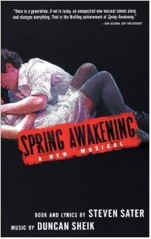 As you may already know, Duncan Sheik and Steven Sater’s Spring Awakening is a musical adaptation of the stage play written by German playwright Frank Wedekind in 1891. Even though most of the dialogue was pulled directly from the original script, it still took almost eight years, from its initial conception in 1999 to its Broadway premier in 2006, to get the musical version to where it is today. And there are some key differences that go beyond the mere addition of songs to the originally straight dramatic text:
As you may already know, Duncan Sheik and Steven Sater’s Spring Awakening is a musical adaptation of the stage play written by German playwright Frank Wedekind in 1891. Even though most of the dialogue was pulled directly from the original script, it still took almost eight years, from its initial conception in 1999 to its Broadway premier in 2006, to get the musical version to where it is today. And there are some key differences that go beyond the mere addition of songs to the originally straight dramatic text:
In the musical, the opening song “Mama Who Bore Me” is derived from a monologue Wendla delivers in Act 2 of the original text.
The entire scene during which Wendla questions her mother about the true nature of how children come to be doesn’t occur until about halfway through the original play.
 There are many more distinct adult characters in the original text.
There are many more distinct adult characters in the original text.
The musical cut multiple adult characters, and also designated that all adult roles were to be played by one male and one female actor.
There is no mention of sexual abuse in the original text.
Sexual abuse was something not talked about at the time it was written, and the vast majority of Spring Awakening was inspired by Wedekind’s own experience or those of his close friends.
The sex between Wendla and Melchior is non-consensual in the original text.
In Wedekind’s original play, Melchior rapes Wendla. The musical version turns this into a consensual act, giving Wendla more control and making Melchior more sympathetic.
After Moritz’ suicide in the musical, his father is depicted falling down in grief at the end of “Left Behind”, whereas he rejects him saying “The boy was nothing to me,” in the original text.
The concept of parenting is vastly different today, and this seems to be a change acknowledging that fact. While the play is set in the 1890s, the audience still lives in the early 21st century making it extremely difficult for contemporary audiences, particularly parents, to reconcile this shunning of a son after having lost him.
In the musical Wendla is taken to an abortionist by her mother in addition to the “French remedy” (code for abortion pill) she is prescribed in the original text.
This addition of seeing Wendla taken to an abortionist is done largely in the spirit of “showing instead of telling,” and provides more closure to her story.
The musical cuts out the part of the Masked Man who convinces Melchior not to kill himself in the original text.
By giving Melchior himself the power to stop himself, the musical version gives adolescents today the message that they have the power to take control of their own lives.
Moritz comes back and tries to convince Melchior to kill himself at the end of the original text. However the musical is much clearer about making Melchior the protagonist throughout, so this change in Mortiz’ attitude helps clear Melchior’s conscious of having played a role in his friend’s suicide.
Wendla does not appear again after she dies in the original text.
But much like the Moritz’ appearance in the musical version, Wendla’s presence offers closure for Melchior, absolving him of any residual guilt he has placed on himself for her death.
What the Dickens?
 This holiday season, Cygnet Theatre is excited to bring back our live radio version of A Christmas Carol. We’ve been doing a bit of research on famed British writer Charles Dickens, author of Oliver Twist, Great Expectations, David Copperfield, The Life and Adventures of Nicholas Nickleby, A Tale of Two Cities and of course, A Christmas Carol and what we found was pretty interesting.
This holiday season, Cygnet Theatre is excited to bring back our live radio version of A Christmas Carol. We’ve been doing a bit of research on famed British writer Charles Dickens, author of Oliver Twist, Great Expectations, David Copperfield, The Life and Adventures of Nicholas Nickleby, A Tale of Two Cities and of course, A Christmas Carol and what we found was pretty interesting.
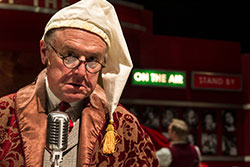
Photo by Daren Scott.
Despite being one of the very first-ever literary superstars, most people don’t know many details of his life. For example, you may be aware that Dickens grew up poor, but did you know that he was mostly self taught? After his father was jailed for having “bad debts,” Dickens was forced to leave school and start work in a blacking factory (a boot polish factory). What about the fact that he knew shorthand? Indeed, his first business card, which he got made at some point between 17 & 19, had his occupation listed as “Short Hand Writer.”
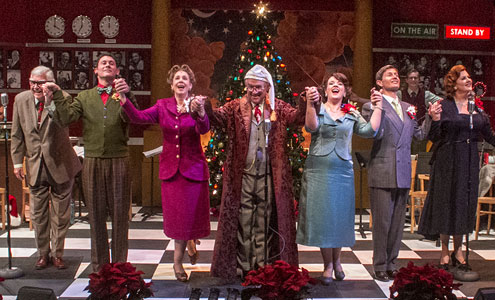
Photo by Daren Scott
Dickens also suffered, at least in childhood, from epilepsy. Having described three of his characters as having epileptic seizures, or ‘The Falling Sickness’ (Edward Leeford in Oliver Twist, a headmaster in Our Mutual Friend, and Guster in Bleak House), modern doctors find his descriptions of the disease remarkably accurate for a period when little was known about it. He probably had OCD as well, and reportedly had a habit of rearranging furniture whenever he stayed in a hotel room having to sleep with his head pointing north, and would inspect his children’s bedrooms every morning, leaving behind notes when he was not satisfied with their tidiness. And those notes were more often than not addressed to “Chickenstalker,” “Skittles,” “Plorn,” or one of the other many nicknames he had for each of his 10 children.
To learn more about this intriguing author, join us on December 8th after the 7:00pm performance of A Christmas Carol: A Live Radio Play for a talkback with Dickensian expert Dr. Edith Frampton, professor of Comparative Literature at San Diego State University. Hope to see you there!
More Split Personalities with Maggie Carney
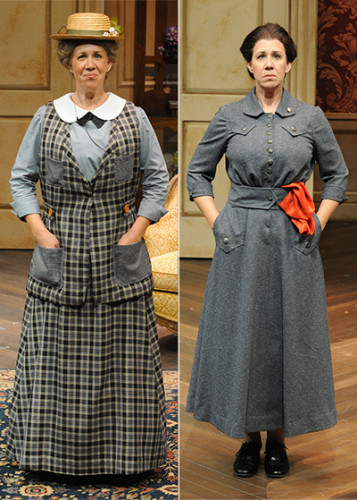
This week we sit down with another actor to talk about her roles in The Importance of Being Earnest and Travesties.
Who are you playing in both shows? What are their similarities, and what are their differences?
I play Miss Prism in Earnest. Prism is Cecily’s governess and companion… she also harbors a deep dark secret. In Travesties I play Nadya, a Russian revolutionary and the wife of Lenin. Nadya came from an upper-class but impoverished home, Prism is middle working class. Nadya and Prism are approximately the same age. Prism has a streak of Socialism and an interest in “causes” compared to the committed Marxism of Nadya, though they are both very passionate about their beliefs on all subjects. They are approximately the same age. Nadya is taller and slimmer than Prism and less fussy. Prism has accessories and tchotchkes that Nadya would never have. And finally, Nadya speaks with a slight Russian accent and Prism is British through and through. These are just some of the similarities and differences.
What is the funnest part(s) of playing multiply characters in Rep?
I love playing multiple characters in any situation, and in rep it’s even more fun. I get to play with the same creative team in 2 different plays! We know each other very well, after rehearsing since the end of July. The real challenge will be remembering what show I’m doing on a given night. I’ve done rep before and there’s nothing like getting dressed for Lady Percy in Henry 4, Part One and realizing at 15 minutes to the top of show I should be in Calphurnia for Julius Caesar! I’ve never gotten undressed and dressed faster in my life.
What are some of the challenges you are facing?
As a supporting actor in both shows, my greatest challenge is to keep my energy level up for my entrances. I must be fully present when I hit the stage to meet the energy level of my scene partners and increase the level with my presence and new information. I fill my down time backstage with crossword puzzles, crocheting and chatting with the other actors who are offstage. And Facebook, too!
If you are able to see both shows, I would highly recommend seeing Earnest first…there are so many echoes in Travesties it is fun to find them after seeing Earnest. Of course, these are stand-alone plays, so however it fits with your schedule, come and see us!
Split Personalities with Jordan Miller
Cygnet’s current production is not one, but two plays, The Importance of Being Earnest by Oscar Wilde and Travesties by Tom Stoppard, performed in rep by the same company of actors. We sat down with Jordan Miller to learn a little about performing in these two classic comedies.
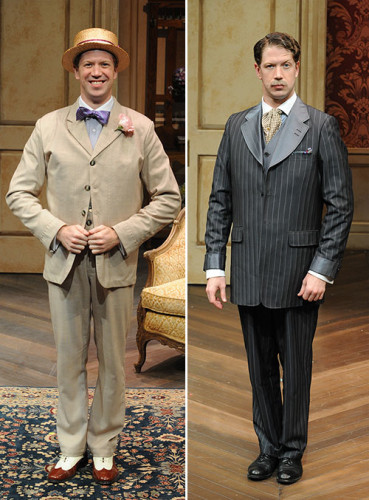
Who are you playing in both shows? What are their similarities, and what are their differences?
I’m playing “Algernon” in The Importance of Being Earnest, and “Henry Carr” in Travesties. The character of “Henry Carr” is inspired from the real life Henry Carr who fought in WWI and who played “Algernon” in a production of Earnest that was produced by James Joyce. The duality of the role in the play is taken from this real-life experience and forms the basis for the nods to The Importance of Being Earnest by Tom Stoppard. Both characters exemplify the “dandy” and boast very elevated and witty language, but “Algernon” is everything “Carr” wishes he was! While “Algernon” is always debonair and relaxed, “Carr” is self important and haughty, “Algernon” always wins in the end, and “Carr” is always left holding the bag. “Algernon’s” opinions and platitudes are always lighthearted but true, and “Carr’s” are always deeply passionate but often one-sided and flawed.
What is the funnest part(s) of playing multiply characters in Rep?
I don’t know if “funny” is how I would describe it but something that has been a delightful frustration for everyone is when the dialogue from one show creeps into the other, especially when the lines are so similar! And what is a great reveal in one show is played upon in the other, often with the substitution of a single word, and when in the moment you forget which show and line it is, it can make for some panic moments inside your head and for your scene partners!
What are some of the challenges you are facing?
With “Algernon” the biggest challenge (as Sean warned!) is constantly eating all the cucumber sandwiches and muffins and still speaking your lines eloquently! The text of both plays is a huge part of what makes them so wonderful; however, the language in both, once it finally gets into your memory, has a tendency to run away with you because it is so musically structured, and while it may be fun for the actor to rip through the dialogue it can become far too fast and clipped to be comfortably followed. With “Henry Carr,” he is more demanding because in addition to his substantial and complex “Old Carr” stream of consciousness memory monologues (Stoppard’s nod to “Ulysses”), he has several heated and impassioned scenes which can, like the dialogue, engulf you in the emotion and suddenly the scene becomes too heated and real and loses its comedic elements. Both characters are delightful to play, and tackling both at once has been an artistically rewarding challenge!
Are their any Rules of Etiquette from the era of Earnest that you wish were still around today?
I think basic rules of etiquette and manners are things which could stand to be reinforced today! Oh, and modern fashion could take some lessons as well.
Behind the Scenes with George Yé
Katie Harroff sat down with director George Yé to talk about the his experience working on Shakespeare’s R&J.
What is your history with Cygnet Theatre?
I’ve been working with Cygnet ever since 2004, I think, way back when Sean and Bill opened the space in Rolando. I designed sound for a number of shows, directed a production of Copenhagen in 2006, and other staged readings. In 2005, I produced and directed an independent project in the Cygnet Theatre space called . . .and then he met a woodcutter. Around that time I was asked to join Cygnet as an Associate Artistic Director. It was an honor I could not pass up. I continued to design, and work on various productions, and helped develop the sound system for the Old Town Theatre. Some years back we produced Escanaba in da Moonlight; for which I won a Craig Noel Award for sound design. I’m deeply committed to the continued growth and development of the company and humbled and overjoyed to participate artistically as well on R&J.
What drew you to R&J?
I love working on Shakespeare. Though I don’t get to do it very often, I actually have some intensive training. Working on this production afforded me the chance get my feet wet with some classic text while at the same time working in a contemporary way. It tells a coming-of-age story fueled with teenage angst, hormones, sensations of first love, and lust. It’s gritty. I like how Calarco’s interpretation of the original text and the students’ story align perfectly and call on the audience to experience the play through a new optic making it seem quite fresh. I was attracted to the potential the play has to challenge and reveal assumptions people have about gender, identity, and also how we can and should interpret and stage classic texts in 2013. I also was very excited to work with some of the great designers who usually work with Cygnet.
What was the hardest part about staging this piece?
The end. The actors and myself deliberated on the ending a number of times. I suspect years from now, I’ll be sitting in a café with a friend and will yell out of nowhere, “Ah! That’s it! That’s what we should have done for the ending!” I waited till very late to set the ending of the play. I knew it was a sacred moment for the cast, and I didn’t want to shut down the creative process too early, yet at the same time, everyone was looking for the right way to end the play. I had to wait and see a few run-throughs with the cast fully committed to each moment before I could start to feel comfortable with a plausible ending.
Why should people come see this show?
It celebrates the medium of theatre on so many levels. The play calls on the audience to use their imagination. Peter Herman the costume designer found us a sturdy bolt of red silk that weaves it’s way through all the action of the play. This elegant prop transforms into many items that help tell the story; vial of poison, rapiers for fight scenes; a knife, a turban, and many more. It really has turned out to be the fifth performer on stage. It’s miraculous to see how the actors use it. It’s a great play for the thrust space in the Old Town Theatre, and it addresses contemporary issues of censorship, oppression of youth, filial love and friendship, the power of first love. It’s something not to be missed.


